Content
- 1 Varietal features of the culture
- 2 Climatic growing conditions
- 3 Color: can you fight it?
- 4 Peking planting methods
- 5 How is the crop harvested and stored?
- 6 Features of Chinese cabbage
- 7 Peking cabbage varieties
- 7.1 Table: an overview of the varieties of Peking cabbage recommended by the State Register
- 7.2 Characteristics of the best varieties
- 7.2.1 Table: characteristics of hybrid Aikido F1
- 7.2.2 Table: description of hybrid Bilko F1
- 7.2.3 Table: the main qualities of the hybrid Goblet F1
- 7.2.4 Table: Characteristics of the F1 Spring Jade Hybrid
- 7.2.5 Table: consumer properties of the Vorozheya variety
- 7.2.6 Table: varietal indicators of the hybrid Hydra F1
- 7.2.7 Table: characteristics of the hybrid Pomegranate F1
- 7.2.8 Table: description of the Lyubasha variety
- 7.2.9 Table: the main qualities of the Manoko F1 hybrid
- 7.2.10 Table: salient features of the Miss China F1 hybrid
- 7.2.11 Table: consumer properties of the Natsuki F1 hybrid
- 7.2.12 Table: varietal indicators of the hybrid Tenderness F1
- 7.2.13 Table: characteristics of the hybrid Nika F1
- 7.2.14 Table: hybrid description Orange Heart F1
- 7.2.15 Table: the main qualities of the hybrid Autumn jade F1
- 7.2.16 Table: characteristic features of the hybrid Autumn Beauty F1
- 7.2.17 Table: varietal indicators of the Richie F1 hybrid
- 7.2.18 Table: consumer properties of the TSKHA 2 variety
- 7.2.19 Table: characteristics of the Khibinskaya variety
- 7.2.20 Table: description of the Yuki F1 hybrid
- 8 Growing Chinese cabbage in the open field
- 9 Growing in a greenhouse
- 10 How to grow Chinese cabbage at home from a stump
- 11 Features of cultivation in different regions
- 12 Diseases and pests of Chinese cabbage
- 13 Table: Possible Problems When Growing Peking Cabbage
- 14 Harvest storage
- 15 Why is it so important to choose the right look?
- 16 Climate dependence
- 17 What colors are there?
- 18 Classification
- 19 Characteristics of the most popular types
- 20 Useful video
- 21 Conclusion

Peking cabbage is a wonderful representative of the cabbage family. In the world this vegetable is known under the name "Chinese salad" and, in fact, looks more like a lettuce variety than cabbage. Peking cabbage has a delicate taste and is usually eaten fresh: it is not very suitable for harvesting and heat treatment. In our country, many gardeners grow this crop on their plots - fortunately, cabbage is unpretentious and easy to care for.
And varieties bred in huge numbers allow you to choose a suitable option for the middle lane, and even for growing in the harsh conditions of Siberia or the Urals. In the article, we will consider the features of the varieties of Peking cabbage, find out how to grow this crop, find out what types of it are suitable for growing in the northern regions of our country.
Overview
Note that Peking cabbage has a high content of fiber, protein, various vitamins, salts, amino acids and minerals, useful for the gastrointestinal tract. I must say that most of all this culture contains vitamin C. And if earlier in our country the only variety of this culture was previously grown and was known - Khibinskaya, but now there are no problems with the choice.Consider the most productive and delicious varieties of Peking cabbage, suitable for growing in Russia.
Early Richie F1
This is a hybrid Peking cabbage, one of the first to ripen. The culture is resistant to mucous bacteriosis - one of the most dangerous diseases for cabbage. Heads of cabbage in this case reach a mass of 2.5 kg, have a dense structure.
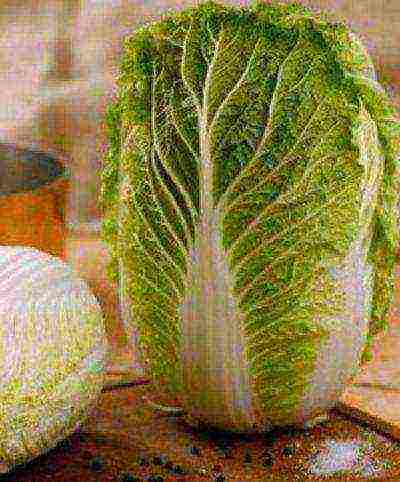
Richie F1
Minus - due to the tenderness of the leaves, the variety is unsuitable for long-term storage.
Vesnyanka
This variety of Peking cabbage amazes with its early maturity. From the moment of planting the seeds to collecting them, it usually takes only 35 days. The head of cabbage is very juicy, perfect for salads, it has a high level of useful vitamin C.
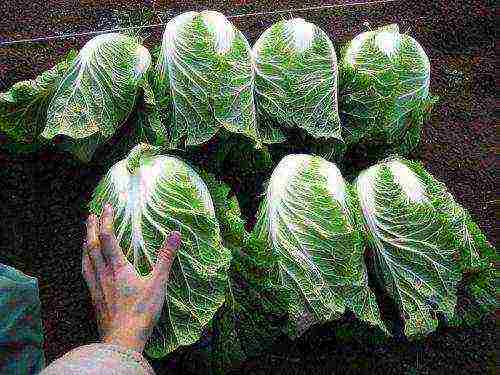
Vesnyanka
Peking broadleaf
Cabbage ripens early, however, it is not keel resistant. Long-term storage of cabbages is not recommended.
Half-cabbage
In this case, we get beautiful heads of cabbage of bright color, and very early. The growing season is only 40 days. It is recommended to grow a semi-cabbage variety in a greenhouse from the very first days of spring. Minus - during long-term storage in the refrigerator, many vitamins are lost.
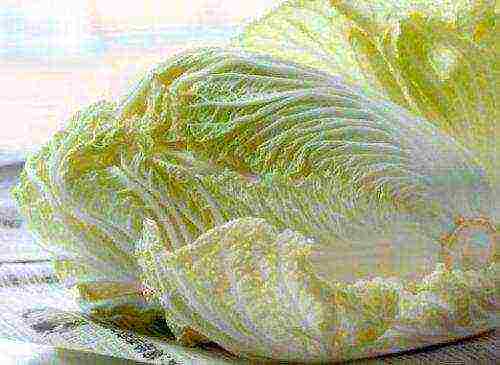
Half-cabbage
TLCA 2
It is an early variety producing small heads of cabbage with excellent palatability. Cannot be stored, only grown for short-term consumption. Recommended for diet.
You may also be interested in learning how to properly water cabbage outdoors.
Lenok F1
A hybrid variety intended for salad use. It is recommended to grow this variety in a greenhouse. The heads of cabbage are small - about 300 grams, on average, but very tasty.
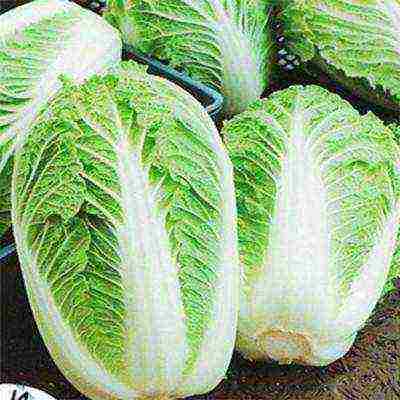
Lenok F1
Mid-season Pomegranate
The variety is one of the highest yielding varieties. Heads of cabbage in this case have a classic elongated cylindrical shape, the leaves are dark green, contain many vitamins. The maximum weight of a head of cabbage is 2.5 kg.
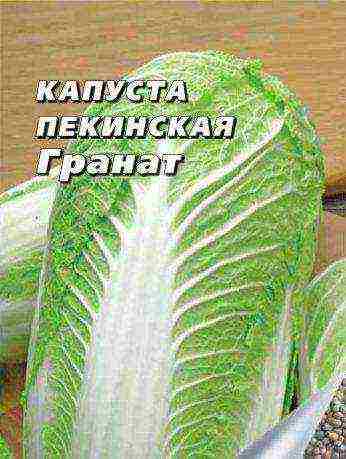
Garnet
Note that this variety is resistant to leaf necrosis (death). You may also be interested in learning about spraying cabbage with ammonia.
Hydra F1
The variety ripens in 2 months on average. As a result of cultivation, we get a beautiful dark green oblong head of cabbage with characteristic yellowish veins. The variety is not stored for a long time, but it is very tasty when fresh.

Hydra F1
Slides f1
The hybrid gives dense heads of cabbage weighing up to 2.5 kg, resistant to cracking. In addition, this cabbage is not sick with keel. Harvests can be stored for a long time in suitable cool conditions. It is one of the few Peking cabbage varieties that are well suited for processing. It will also be useful to learn about how to treat cabbage from aphids with folk remedies.
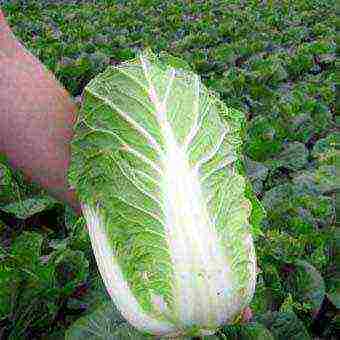
Slides f1
Lyubasha
This variety has a very pleasant taste and a wonderful fresh aroma. It can be used in salads and as a side dish.
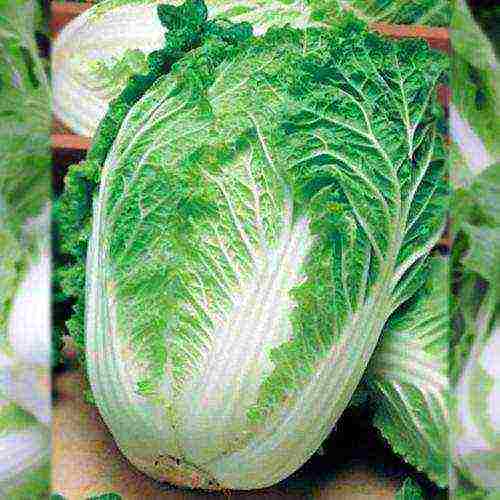
Lyubasha
Bilko
Heads of cabbage in this case ripen in 60-65 days, weigh up to one and a half kilograms. The leaves are crispy with a pleasant sweetish taste. It is recommended to store this cabbage for no more than two months.
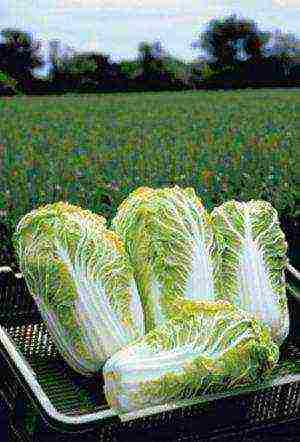
Bilko
Late Wine Glass
This variety ripens in 70 days, which can be attributed to the mid-late period. Heads of cabbage "Glasses" grow up to 2 kg in weight, have a high density, and are distinguished by a pleasant light green color.
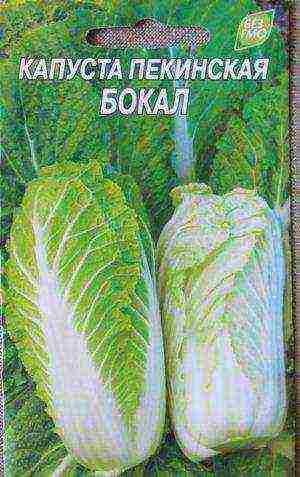
Wineglass
This variety is quite capricious, therefore it is recommended to grow it in a warm climate.
Nika
It is a hybrid cabbage variety resistant to keel as well as flowering. A characteristic feature of this variety is a waxy coating on the leaves, and their strong wrinkling. The variety can be cultivated both in the greenhouse and in the open field.
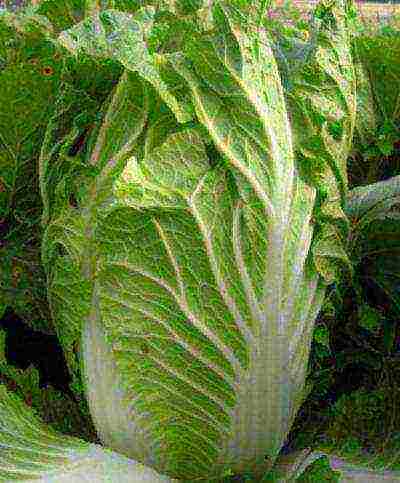
Nika
Heads of cabbage are suitable not only for fresh consumption, but also for processing, which, in general, is not very typical for Peking cabbage. The fruits are very dense, weighing up to 3 kg.
Monument
In this case, the crop can be seen 70 days after planting.And this is one of the highest yielding varieties. In addition, the heads of cabbage in this case are very dense, reaching 3.5 kg.
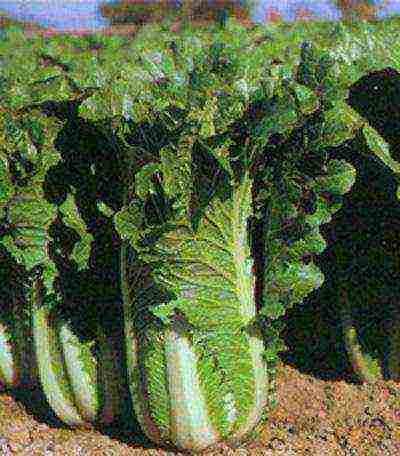
Beijing
Reviews
Let's get acquainted with the reviews of the varieties of Peking cabbage from farmers and summer residents who grow this crop.
- Dmitry, Yekaterinburg: “I have wanted to grow Peking cabbage for a long time, but I was worried about the variety. Finally, the zoned varieties appeared, and I immediately planted several of them. Most of all I liked the Orange Mandarin cabbage. The variety is easy to care for, and grows remarkably even outdoors in cool weather. I recommend this variety as the most suitable for our Ural area. "
- Valentina, Yaroslavl: “I grow a lot of vegetables at my dacha, just recently I planted Peking cabbage. This culture is new to me, but there are already first successes. I chose early and medium varieties - Vesnyanka and Gorki. Vesnyanka is very tasty, it goes great for salads - we eat the whole crop quickly. Slides ripen longer, but they are well stored - usually heads of cabbage sit without problems all winter. In addition, this cabbage can be processed - it is also very good in salted and sauerkraut form. I recommend to all gardeners and summer residents to plant Peking cabbage - a culture that is easy to care for, but it gives a huge charge of vitamins. And it’s just very tasty. ”
And here you can read the gardeners' reviews about the early white cabbage variety
Recommendations
Here are some useful tips from experienced gardeners about growing Chinese cabbage.
In order for the cabbage to ripen well and quickly, it must be provided not too hot conditions (+ 16-20 degrees), as well as short daylight hours. In the conditions of white nights in our Russian north, Peking cabbage quickly blooms without shelter, ceasing to form a head of cabbage.
You may also be interested in knowing what late varieties of white cabbage exist for pickling.
Young Peking cabbage requires abundant watering, since in the event of a lack of moisture it can stop growing altogether. This is due to the fact that the root system of the plant is superficial, and is not able to extract moisture from the depth of the soil.
On the video - varieties of Peking cabbage:
The plant needs regular feeding throughout its growing season. Nitrogen-containing fertilizers (mullein or mineral complexes) are especially important for cabbage.
As for pests, the lice is a particular problem for young cabbage leaves. To cope with this scourge, it is recommended to regularly sprinkle wood ash over the garden bed.
Varieties for Siberia and the Urals
Choosing a variety of Peking cabbage suitable for these regions, it is necessary to take into account the cold resistance of the culture, and the period of time during which the vegetable ripens. Experts recommend choosing early varieties for cultivation in cold climates. In this case, the culture will have time to ripen even if the summer is short and cloudy.
If the climate is very harsh, Peking cabbage can also be grown in a greenhouse. Late-ripening varieties can also be used for the greenhouse, since external conditions cease to be of particular importance.
When grown in areas with white nights, it is important to know that Chinese cabbage, in the absence of darkening, cannot fully form heads of cabbage. Therefore, if you live in a region with just such a climate, be sure to artificially darken the beds. Otherwise, the harvest may not be expected.
Overview Russian size
This variety is great for growing in regions with a harsh climate, since it was originally adapted for it. Domestic scientists were engaged in the selection of this species, therefore, all factors that are important precisely for Russian reality are provided for: cold resistance of the culture, unpretentiousness to the soil, early ripening.
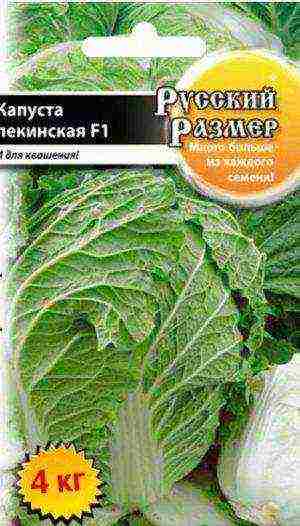
Russian size
And in addition to all these advantages, "Russian size" also has a significant size, growing up to 4 kilograms.
Cha-cha
This Peking cabbage can be successfully cultivated in the Urals, but the variety shows a special yield when grown in the middle lane. Cha-cha is cultivated in a seedless way, which makes life much easier for gardeners and farmers.

Cha-cha
The variety is early ripe: 50-55 days pass from the moment of laying the seeds to harvesting. The maximum weight of a head of cabbage in this case is 2.8 kg. But how is the cultivation of Peking cabbage cha cha. This information will help you understand.
Orange tangerine
This variety can be cultivated all summer, as it grows very quickly. If weather conditions and care are favorable, then the first heads of cabbage can be harvested just 40 days after the seed was set.

Orange tangerine
The average weight of a head of cabbage is 1 kg. Most experts call this variety optimal for cultivation in Siberia.
Yuki F1
This is a hybrid species, usually grown under film. Thanks to this growing method, the crop can be harvested very early. The hybrid is also good because it has resistance to many characteristic diseases of the culture.
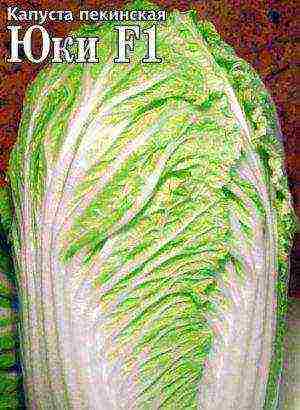
Yuki F1
Beijing Express
This variety of cabbage can be cultivated both in greenhouses and outdoors. An extremely unpretentious look, it can easily withstand even significant temperature changes.
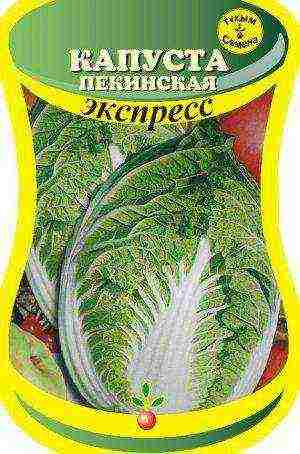
Beijing Express
The weight of "Express" cabbages reaches 2 kg, the shade of the leaves is light green. It is resistant to the invasion of ground pests.
Brocken F1
This hybrid belongs to mid-season varieties, adult heads of cabbage reach a weight of 2.5 kg. Note that Brocken cabbage does not bloom, and besides, it is perfectly stored.
So, we examined the features of various varieties of Peking cabbage, found out which of them are suitable for cultivation in the north of the country. As you have seen, there are a lot of different varieties of this culture: you can choose among early and mid-season ones, resistant to certain diseases, and having other positive properties. Be sure to plant this cabbage on the site: and your diet will be enriched with a vitamin, healthy and tasty vegetable.
The cultivation of Chinese cabbage, or Peking, is subject to the climatic conditions of the area, and planting is carried out only in spring or summer. The main condition of work is to choose the best varieties of Peking cabbage for your region, to observe agricultural technology. By choosing the right type of vegetable, you will get a very good harvest. Agronomists advise purchasing material with early, middle and late ripening periods - this guarantees the continuity of obtaining heads of cabbage.
Varietal characteristics of the culture
Tasty and healthy Peking cabbage resembles a salad in the shape and structure of its leaves. Actually, only tender and juicy foliage is used for food - salads are prepared from it, and heads of cabbage are used for soups, marinades or dried.
Description of the vegetable
The plant, called head lettuce, forms leaves collected in a rosette up to 40 cm in diameter. The length of the foliage is 40 cm, and the color varies from pronounced green to light green. Fresh head of cabbage - elongated, with good looseness, weighs from 1 kg or more.
Specificity of agricultural technology
The foliage has a sweetish taste, a pronounced aroma and a fast growth rate. An ovary of up to 6 leaves can be used in cooking without removing it from the beds - the cut leaf will grow back quickly. Cultivation of a plant in a garden plot is carried out taking into account its characteristics:
- poor transplant tolerance. Seeds are germinated in containers made of peat, and when transferred to the ground, they try not to touch the roots. Seedlings are placed in the soil mixture at the end of April, and in the middle of May they are planted in the ground;
- propagation by seeds and seedlings. Grains are sown in planting holes, 1-2 pcs., Keeping a distance of 30-40 cm (early varieties), 40-50 cm (late-ripening crops);
- the probability of shooting.The vegetable needs to be thinned out at the stage of formation of 3 - 5 leaves;
- exactingness to the soil. The soil must be fertilized with 1 bucket of humus and 2 tbsp. l. nitrogen-phosphorus additives per 1 m 2. The planting site is limed with dolomite flour or treated with ash from the roots of the culture.
Beijing needs to be watered regularly. Dense heads of cabbage form in open, sunny areas.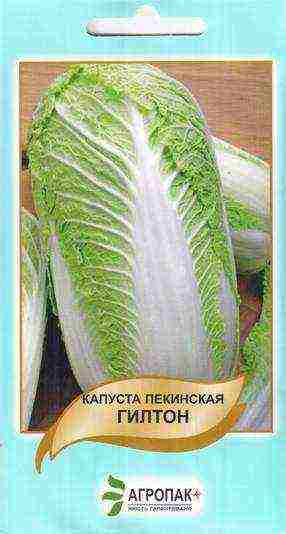
Lighting regulation
To prevent Beijing from releasing arrows, use a non-woven fabric. The canvas controls the sun's access to seedlings and normalizes the microclimate:
- eliminates the risks of damage to crops during frost;
- minimizes the likelihood of plant overheating in sunny weather;
- isolates excess moisture, preventing decay;
- eliminates leaf damage by cruciferous midges.
Good precursors for Chinese cabbage are garlic, onions, cucumbers, potatoes, and carrots.
Climatic growing conditions
The Asian plant is suitable for central Russia, but only when planted during a season with long daylight hours. The suitable temperature range for normal cabbage growth is 13-20 degrees. Lighting must be regulated - with heat-loving nature, the vegetable does not tolerate excessive exposure to the sun.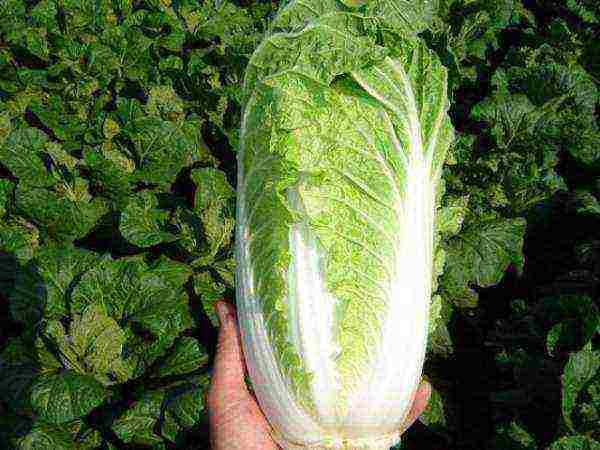
Vegetable cultivation in Siberia and the Urals
Hybrid varieties of Peking cabbage for Siberia are planted in greenhouses, only when warmth (+18 degrees) comes, the plant can be transferred to open ground. For the climatic conditions of the Urals, those varieties of culture are suitable that take root well in Siberian weather:
- Richie F1. A hybrid variety that does not undergo bacteriosis. Heads of cabbage with a very strong density weigh about 2.5 kg. The heads are not stored for a long time, therefore they are used only in salads;
- Nika. An early hybrid that does not undergo keel. Leaves with a waxy bloom are slightly wrinkled, but juicy. Propagated by seeds and by placing seedlings in open ground;
- Khibinskaya. Cultivation in Siberian conditions is justified by a fast growing season in the beds (40-50 days) and in greenhouses (25 days). Cylindrical heads of cabbage develop optimally with a short day length;
- Northern Beauty F1. Resistant to the formation of arrows, early ripening - the growing season is about 55 days. The dense barrel-shaped heads weigh approximately 2.8 kg. The leaves are rich in proteins, carbohydrates, pectin, and are resistant to decay;
- Orange tangerine. It is sown during the summer season. Early ripening variety - heads of cabbage are formed in 40 days. Due to a good harvest at low temperatures, it can be planted in Siberia;
- TSKHA 2. Yielding variety with large light green leaves;
- Beijing Express. Ripens later than the early varieties presented, but is optimal for growing in garden beds and greenhouses. Adapted to unfavorable climates, forms light green heads of cabbage weighing 2 kg.
For disembarkation in the Siberian and Ural climates, it is recommended to choose Peking, which ripens earlier. A culture that bore fruit before the beginning of autumn is not subject to frost and disease, and is suitable for all-season salad preparation.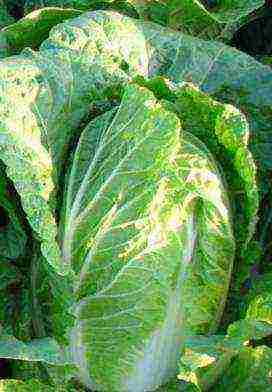
What kind of Chinese cabbage is grown in the Moscow region?
The entire line of Peking varieties for the Moscow region was developed by breeders taking into account the climate and soils of the region. Gardeners of the Moscow Region, with sudden changes in temperature and moderate coolness, cultivate several types of Chinese cabbage - very early and late:
- Victoria. The early appearance (growing season - only 50 days) is distinguished by dense, long and slightly convex heads of cabbage. Juicy foliage with a fresh taste is used for making salads. Heads of cabbage can be stored for a very long time - almost 90 days;
- Russian size. The hybrid variety is resistant to adverse weather. The growing season is about 80 days. A late-ripening head of cabbage, with proper agricultural technology, reaches a weight of 4 kg;
- Cha-Cha.Suitable for growing in a climate of the middle zone. It is planted with seedlings or seeds, characterized by an average ripening rate of 55 days. The heads have a mass of about 2.8 kg;
- Yuki. An early maturing variety that sprouts quickly under film. Cabbage is resistant to diseases, transported without damaging the head of cabbage;
- Garnet. A high-yielding variety with dense dark green heads of cabbage weighing 2.5 kg. Pomegranate resistant to necrotic formations;
- Hydra. A medium-ripened culture (55 to 60 days) forms half-open heads. Wrinkled dark green heads of cabbage do not last long;
- Vesnyanka. Leafy early ripening Peking - 35 days are enough for full vegetation. The core is quite juicy, therefore it is suitable for making salads;
- Wineglass. The growing season is 70 days, but the crop can only be grown in greenhouses. Elliptical heads of cabbage weighing 2 kg are dense, painted in a bright green hue.
When cultivating Chinese cabbage on the territory of the Moscow Region, it is important to take into account the climatic features of the region. Most varieties do not take root in a transitional climate, so it is advisable to germinate seedlings in a greenhouse.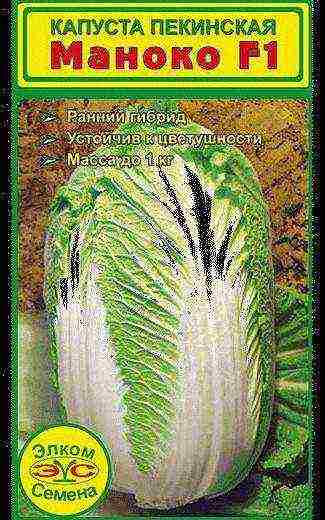
Color: can you fight it?
In the process of growing with a long daylight hours and an increase in air temperature, some varieties of Peking will throw out an arrow. To prevent shooting, gardeners use two techniques.
Correct selection of varieties
The varieties of high-yield Peking cabbage presented below are mostly resistant to the formation of flowering. For self-cultivation, the following are justified:
- Champion. A hybrid variety, the technological ripeness of which occurs 65-70 days after planting. The crop is distinguished by a very high yield, oval-shaped heads of cabbage weighing up to 2 kg;
- Manoko. Designed for growing during the warm season, planted in open ground or greenhouses. Heads of cabbage glasses have a cylindrical shape, light green color, resistant to browning of foliage and fusarium;
- Miraco. Early maturing variety (vegetation 45-52 days), which is cultivated at low temperatures. The plant is resistant to shooting. Dense green heads weigh about 1.5 kg;
- Optical. Rapid technological maturity - about 60 days determines the short-term storage of the vegetable. Grown in cold climates, does not undergo powdery mildew and fusarium. The oval light green heads weigh approximately 1 kg;
- Bilko. A hybrid variety with a very high yield. An elongated head of cabbage with a rich green hue weighs 1.5 kg. Cabbage is distinguished by its long keeping quality, its market and transport indicators are above average;
- Custar. An early hybrid ripens 55 days after placing the seedlings in the ground. The best harvest is harvested in spring and autumn, consumed fresh. The core is juicy and sweet in taste;
- Gilton. A variety with a medium ripening rate. After 58-65 days, a closed green head of cabbage is formed. The leaves retain their taste during short-term storage. The head weighs 1 kg.
When buying seeds, you need to pay attention to the keeping quality of the vegetable. Some varieties can be stored in the basement or salted, while others are only suitable for salads.
Independent color control
To prevent the formation of arrows, cabbage is recommended to be planted in areas illuminated, without access to drafts. Color does not occur if:
- seedlings were not hardened;
- the root system is not damaged;
- a distance of 30-40 cm is observed between seedlings;
- the soil was fertilized with organic matter and minerals in advance.
Practically no fertilizing is applied to loose soil. Cabbage is fertilized with nitrogen complexes only during the growth period. Nitrates are absorbed by the plant in 14 days.
Peking planting methods
On the territory of Russia, cabbage salad is grown by seedlings or seeds. Summer residents are comfortable with the first method, because it contributes to a good harvest.When planted in open ground, heads of cabbage are formed later, which is not justified for regions with low temperatures.
Seedling technique
You can plant early-ripening Peking species in March, and late-ripening cabbage in the last week of June. The work is carried out as follows:
- Prepare the soil by introducing the substrate. It is prepared from peat, turf and sand in equal proportions.
- Seedlings are taken out without hardening. To do this, the seeds are placed in 1 cm peat containers, watered with warm water and left for 3 days.
- The overgrown material is placed in a lighted area and watered regularly.
- After 25 days, the seedlings are transferred to open ground, pre-hardening is carried out.
- The sprouts are placed in the soil, keeping a distance of 35-40 cm between the holes. The row spacing is done at a distance of 50 cm.
- A nutrient mixture based on 500 ml of water, 500 g of humus and 2 tbsp. Is placed in each hole. l. wood ash.
It is necessary to plant shoots carefully, without bending the roots. The soil must be rammed, and the plant is watered at the root.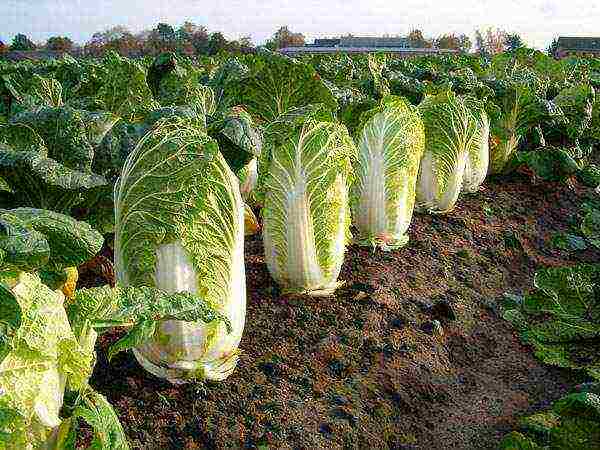
Sowing the grains
When sowing material in open ground, only warm weather should be selected. The holes are made according to the principle similar to seedlings - the distance between the seedlings is 40 cm and the inter-row distance is 50 cm. The grains are placed at a depth of 1-2 cm to accelerate germination. A film or agrotextile is laid on the bed to protect it from cold snaps.
The cultivation technique does not depend on the variety of the cabbage. The short growing season allows the plant to be planted twice per season. To obtain seeds, the culture grows during the period of increasing daylight hours, and to prevent blooming, it is planted when the daylight hours are shorter.
How is the crop harvested and stored?
Peking cabbage is grown for two purposes - for the culinary use of leaves or heads of cabbage. If you plan to prepare salads, you can pluck foliage that has reached a length of 10 cm. To collect heads of cabbage, check the rise of the tops - it is as close to the stump as possible.
The shelf life of Pekingi depends on the location of the leaves on the head. Open ones (Aikido, Brokken, Princess, Spring Beauty) are eaten immediately. Closed (Glass, Spring Jade, Sentyabrinka) are stored from the moment of harvest until December-February. Plants with good keeping quality can be refrigerated.
When cultivating cabbage lettuce in the climate of Russia, it is important to choose varieties of Peking cabbage that are fruitful and resistant to flowering, or to plant the material at a strictly defined time of the year.
Once a neighbor treated me to Chinese cabbage. The head of cabbage was large, even, strong and had the shape of a torpedo. Before that, I was sure that such ideal handsome men live only in the store. And here in the neighbor's garden! It was in June. A neighbor, touched by my delight, shared a packet of seeds so that I could taste my harvest in the fall. Well, I gave a course for a young lover of "Peking", of course. In September I already admired my heads of cabbage. It turned out to be no more difficult to grow it than ordinary cabbage. The crop can be obtained twice a year if you know all the features of cultivation.
Features of Chinese cabbage
Peking cabbage, it is salad, or Chinese, or petsai. It is a cold-tolerant herbaceous biennial vegetable, although in practice it is more often grown as an annual. It has head and leaf varieties. Heads of cabbage have an elongated shape, 30-60 cm long. Color - from light yellow to bright green. Peking cabbage tastes like Romano salad - just as juicy and firm. Its leaves contain:
- protein (up to 3.5%);
- vitamin C (five times more than lettuce leaves);
- vitamins B1, B2, B6, PP, A, E, K, U;
- citric acid and carotene in large quantities;
- mineral salts;
- 16 amino acids, including essential ones.
Peking is used, just like other types of cabbage. She does not have a specific cabbage smell. Therefore, the dishes are more refined in taste and aroma.The content of vitamins B1, B2, B12, PP in sauerkraut is higher than in fresh one. And also there are many biologically active components in it, thanks to which Peking cabbage not only nourishes, but also heals.
The famous Korean kimchi is Chinese cabbage. For Koreans, this is the main dish on the table.
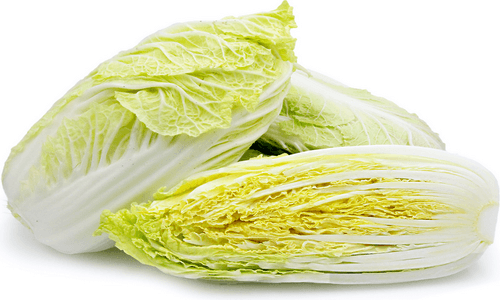
Chinese cabbage is a great food
Chinese cabbage is especially beneficial for cardiovascular diseases, headaches, depression and anemia. The high content of lysine - an amino acid that dissolves foreign proteins, cleanses our blood and improves immunity. And 100 g of Chinese cabbage contains only 16 kcal. At the same time, the body spends more calories on digestion than it receives from it. Therefore, to the question of what to eat in order to lose weight, there is an answer - Chinese cabbage salad!
Peking cabbage is rich in coarse vegetable fiber. In this regard, it should be used with caution by people with diseases of the digestive system: high acidity, gastritis and stomach ulcers.
Chinese cabbage is able to retain all its nutrients for three months. Therefore, it is difficult to replace it with something in the fall. Salads cannot be stored for that long. And white cabbage is inferior to Peking cabbage in taste and nutritional qualities and requires more difficult storage conditions.
Peking cabbage varieties
Peking cabbage is a newcomer to the State Register of Breeding Achievements Approved for Use. Domestic agronomists became interested in it only in the 80s of the last century. So Russian varieties are still young, but already quite diverse. The State Register recommends us at least fifty varieties for growing in Russia. In general, they can be divided into:
- early - the harvest grows for 40–55 days;
- medium - 55-60 days before heading;
- late - 60–80 days of ripening.
To provide yourself with a continuous harvest throughout the season, it is more correct to grow plants of both early, and middle, and late ripening periods.
Table: an overview of the varieties of Peking cabbage recommended by the State Register
Characteristics of the best varieties
The most popular varieties among our gardeners are those that are distinguished by excellent taste, resistance to shooting and diseases.
Table: characteristics of hybrid Aikido F1
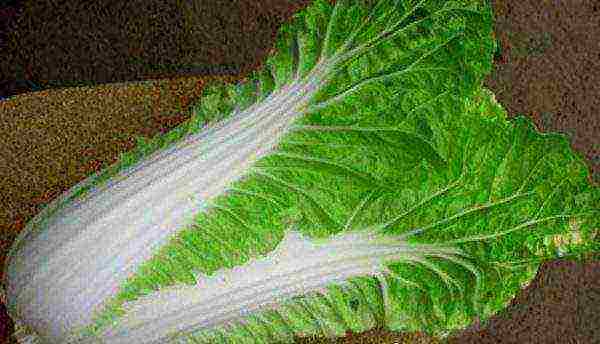
Peking cabbage variety Aikido F1 tolerates heat well
Table: description of hybrid Bilko F1
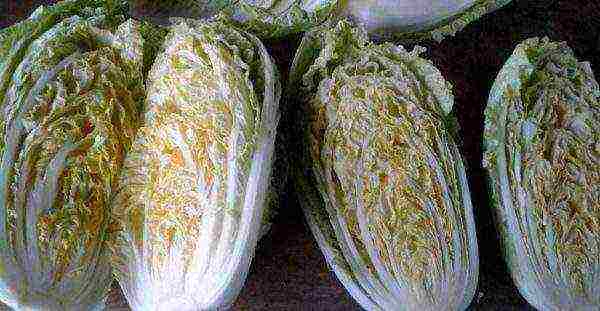
Peking cabbage of Bilko F1 variety is resistant to fusarium and other plant diseases
Table: the main qualities of the hybrid Goblet F1

Peking cabbage of the Bokal F1 variety of medium late ripening is leading in terms of taste
Table: Characteristics of the F1 Spring Jade Hybrid
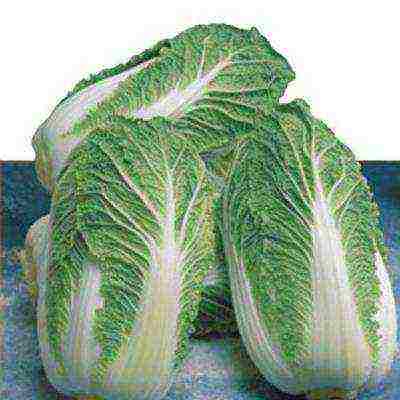
Heads of Peking cabbage variety Spring nephrite F1 are large in size
Table: consumer properties of the Vorozheya variety

Peking cabbage of the Vorozheya variety has an excellent taste
Table: varietal indicators of the hybrid Hydra F1
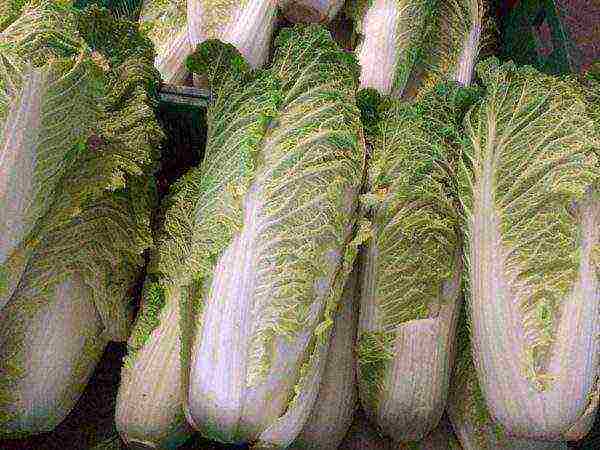
Peking cabbage Hydra is disease resistant
Table: characteristics of the hybrid Pomegranate F1
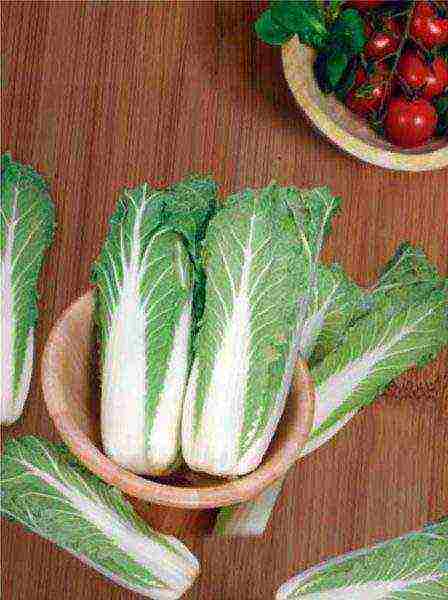
Peking cabbage of the F1 Pomegranate variety is very productive
Table: description of the Lyubasha variety

Peking cabbage of the Lyubasha variety has an unusual pleasant aroma
Table: the main qualities of the Manoko F1 hybrid
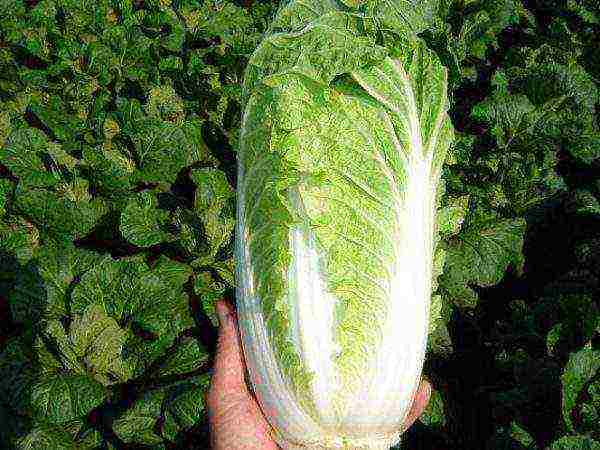
Peking cabbage of Manoko F1 variety can be planted in summer, as the plant perfectly tolerates heat
Table: salient features of the Miss China F1 hybrid

Peking cabbage of the Miss China F1 variety is suitable for making Korean kimchi
Table: consumer properties of the Natsuki F1 hybrid
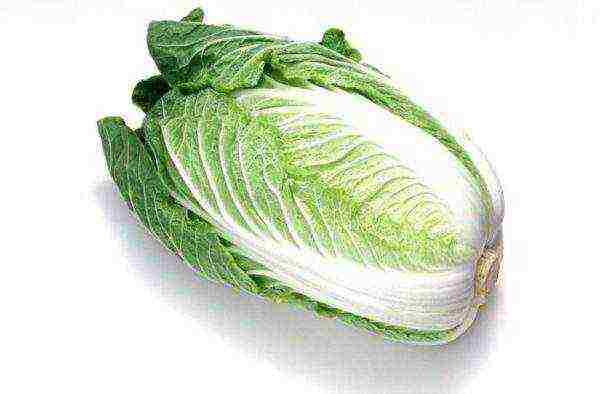
Peking cabbage variety Natsuki F1 extremely early maturing
Table: varietal indicators of the hybrid Tenderness F1
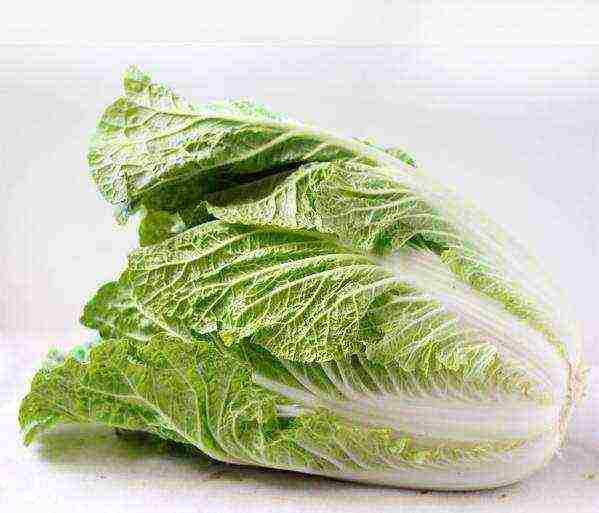
Peking cabbage of the Tenderness F1 variety is suitable for growing in the open field and in a greenhouse
Table: characteristics of the hybrid Nika F1

Peking cabbage of the Nika F1 variety is well stored in winter
Table: hybrid description Orange Heart F1

Peking cabbage of the Orange Heart F1 variety is considered one of the most beautiful
Table: the main qualities of the hybrid Autumn jade F1
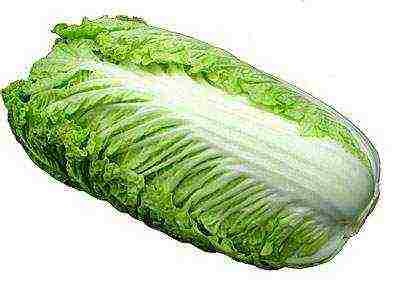
Peking cabbage variety Autumn Jade F1 is used for fermentation
Table: characteristic features of the hybrid Autumn Beauty F1
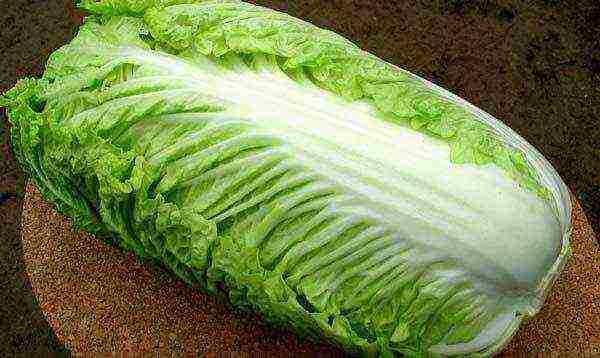
Peking cabbage of the Autumn Beauty F1 variety is distinguished by its unpretentiousness
Table: varietal indicators of the Richie F1 hybrid
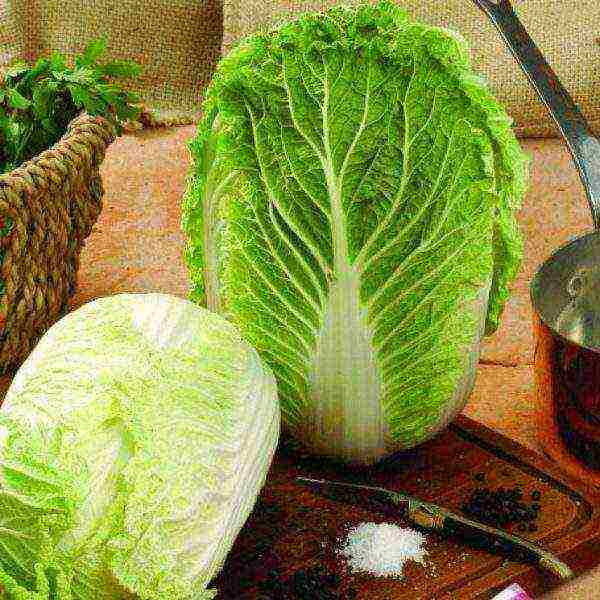
Peking cabbage of the Richie type F1 has dense massive heads of cabbage
Table: consumer properties of the TSKHA 2 variety
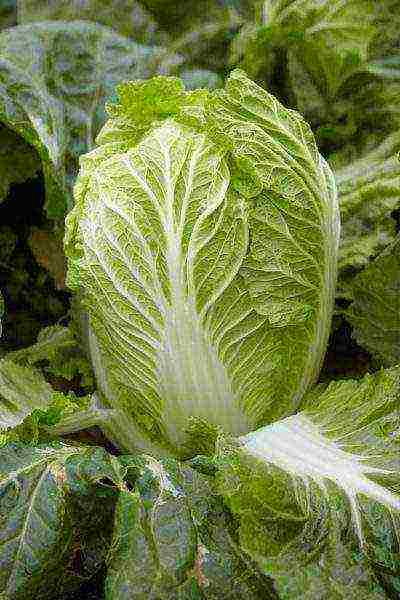
Peking cabbage of the TSKHA 2 variety gives an early harvest
Table: characteristics of the Khibinskaya variety
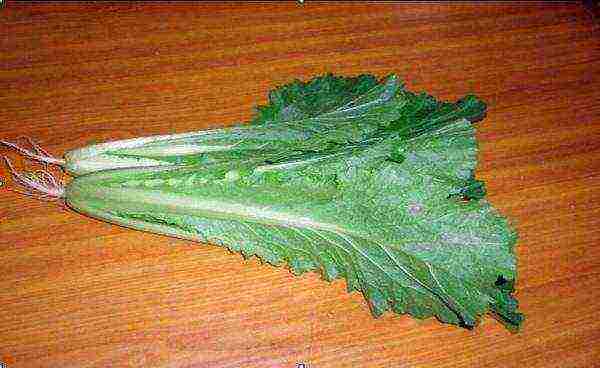
Peking cabbage of the Khibinskaya variety can be used in the leaf phase of ripeness, without waiting for the formation of a head of cabbage
Table: description of the Yuki F1 hybrid
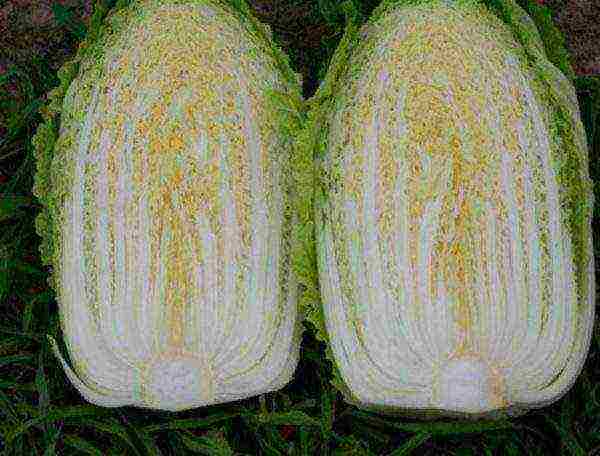
Peking cabbage Yuki F1 is cold resistant
Growing Chinese cabbage in the open field
Peking can be grown both outdoors and in a greenhouse. Each method has its own characteristics.
Peking cabbage grows well outdoors. Moreover, in the open air and in good light, it accumulates much less nitrates. True, she has one feature that endangers a good harvest. From sudden changes in temperature, Peking cabbage immediately begins to bloom.

The first shoots of Chinese cabbage appear in a week
Landing
The first planting in open ground should be started in April. It is better to start the second landing in the 20th of July. By the way, by the end of July, garlic is usually harvested from the beds. Planting Chinese cabbage in its place is a great idea.
During the day, it is better to cover the bed with a film, raising it only for watering. The distance between plants should be:
- for a leaf form - 20 cm between rows and the same amount between plants;
- for the head form - 35 cm between rows and 25 cm between plants.
For better lighting and ventilation, it is useful to plant plants in a checkerboard pattern.
Chinese cabbage will grow well after potatoes, carrots, onions, garlic, and legumes. She does not like acidic soils, which means that it is better to lime the land in the garden. You need to plant seeds in moist soil.
Watering
Peking cabbage is demanding watering. The higher the temperature, the more often it is carried out. Optimal watering - irrigation and sprinkling, absolutely ideal - drip moistening. Water stagnation in the beds should not be allowed, white cabbage loves this, but Chinese cabbage does not.
It is interesting that with similar names, Peking and white cabbage are very distant relatives. Peking is a subspecies of turnip.

Peking cabbage should be watered in the morning or evening.
Top dressing
Peking cabbage, like any normal plant, loves fertile soil. When planting seedlings and later, at the initial stage of setting the head of cabbage, the plant needs nitrogen. For further growth, the culture needs phosphorus and potassium.
You can feed it with a solution of bird droppings or mullein: 500 g of fertilizer per 10 liters of water. For each bush, you need to take 1 liter of infusion.
Growing in a greenhouse
In a greenhouse, it is more productive to grow Peking cabbage through seedlings - we will get a harvest faster. Since the plant ripens quickly (40–55 days on average), it can be planted between rows of tomatoes or cucumbers. She will have time to ripen and leave the greenhouse while the neighbors grow up.
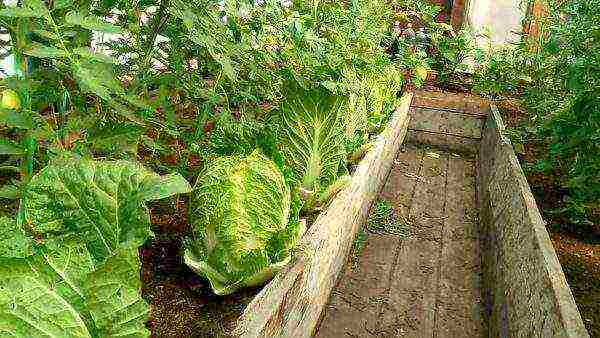
Peking cabbage in a greenhouse is an excellent "compactor" for tomatoes and cucumbers
The main difficulty in growing Chinese cabbage in a greenhouse is the high temperature during the day.... The optimum temperature for this culture is 20 ° C.
Transplanting
Peking cabbage does not tolerate transplanting well, so the seedlings should be immediately planted in separate containers. Planting seeds should be done in the second half of March. The best option would be to plant them in peat pots. Then, when planting in the ground, the root system will not be damaged.
The beds need to be prepared in the fall.This culture needs a neutral soil with a Ph acidity of 6.7-7.4. Loam works well. If the acidity is higher, add lime or dolomite flour. In the spring, when digging, add a bucket of compost or humus for each m2. On acidic soil, Peking cabbage will be affected by keel, a common plant disease.
Planting Chinese cabbage seeds for seedlings should be carried out in compliance with the following rules:
- Dry seeds should be planted in moist soil without presoaking.
- Put 2-3 seeds in a hole 1.5 cm deep.
- The distance between the rows is about 30 cm for the early varieties and 40 cm for the later ones.... The same distance should be between plants.
- Water sparingly, avoiding waterlogging and drying out of the soil.
- When the third leaf appears, remove weaker plants from the hole, leaving one strong sprout.
When grown through seedlings, a seedling with six leaves can be planted in the ground (in the fourth week of life).
If the plants are planted too densely, then they will not begin to tie the head, but will grow in the form of a lettuce.
Providing watering
Peking cabbage is hygrophilous. It should be watered 2-3 times a week. It is best to equip her with drip irrigation. To retain moisture, cover the ground with mulch, such as straw.
Fertilization
Fertilizers must be used carefully, because this cabbage easily accumulates nitrates.... It is enough to add top dressing to the soil before planting. It is not necessary to fertilize the cabbage during the growth process. Nitrogen-containing fertilizers are best suited for Chinese cabbage: mullein, weed infusion or complex mineral fertilizers.
To prevent nitrate build-up, it is important that at least two weeks have elapsed since the last top dressing before harvesting.
Care
You can spud cabbage twice: 20 days after planting, and then another 10 days later. The "Peking" root system is shallow, so it is necessary to cultivate the land around it carefully.
Video: the main mistakes when growing Chinese cabbage
How to grow Chinese cabbage at home from a stump
It is amazing, but a new plant can be grown from a cabbage stump! It is enough just to put the cut off lower part of the head of cabbage with a height of at least 5 cm in a cup of water.

Unique Chinese cabbage can revive itself even from the stump
The cup with the stump should be placed in a cool place. When fragile roots appear in a week, the plant can be carefully transplanted into a pot with soil. Water without fanaticism - Peking cabbage does not like swamps. The top should rise above the ground. The growing leaves can already be eaten. And if you plant this new plant in an open ground or greenhouse, then it will soon turn into a real head of Chinese cabbage. Such a miracle.
Features of cultivation in different regions
The process of growing Chinese cabbage in different regions is not fundamentally different. When cultivating this crop in the zones of Siberia and the Urals, it is worth choosing more cold-resistant and early varieties, as well as a seedling and greenhouse cultivation method. Peking cabbage loves to be cool. The optimum temperature for it is 8 ° C at night and a maximum of 18 ° C during the day. At high temperatures, cabbage blooms faster.
It turns out that the central part of Western Siberia with its average summer temperature of + 15.5 - 18 ° C is the optimal place for growing Peking cabbage.
In northern regions with "white" nights, you need to think about how to darken the plantings, for example, cover with a dark non-woven material, since the head of cabbage will not form due to the long daylight hours.
In the middle lane and the Moscow region, you can grow any Russian varieties.
Diseases and pests of Chinese cabbage
To prevent many diseases of Peking cabbage, you need to take care of the soil on which it grows. To protect the plant from pests, you should adhere to the basic rules:
- In no case should you plant it in the beds after cruciferous plants, which suffer from the same pests and diseases (radish, turnip, radish, other types of cabbage).
- To avoid keels (an ugly tuber instead of a root), you need to reduce the acidity of the soil. Clay and peaty soils must be limed: 100 g of canned lime per 1 sq. m.
Chinese cabbage lovers among insects are aphids, slugs, cabbage whites and cruciferous fleas..
Cruciferous flea
The cruciferous flea lives in the upper soil layer, hibernates in plant debris, and feeds on cabbage leaves. Pest control methods:
- weeding;
- harvesting plant residues after harvesting;
- planting onions, garlic, tomatoes or petunias next door;
- processing with tobacco dust, wood ash, infusion of garlic, potato tops or tomato tops.

The cruciferous flea can do a lot of damage to the Beijing cabbage crop
Aphid
Aphids live on the underside of Chinese cabbage leaves. It feeds on plant juices, which is why the culture does not grow well and is deformed. Ways to combat aphids:
- planting in the neighborhood of umbrella crops: dill, carrot seed plants;
- spraying with infusions of onions or tobacco.
Slugs
Slugs live on the plant and eat all of its parts. Very dangerous and voracious enemies. To combat them, you need to mix wood ash, red pepper, salt and dry mustard. In dry weather, sprinkle the ground near the bushes, loosen a little. Plants can also be sprinkled with ash, red pepper and mustard.
Cabbage white
This butterfly is dangerous in that it lays eggs on the underside of the leaves of Peking cabbage. Caterpillars emerge from the eggs and gnaw right through the plant. They can be removed manually. You can make a spray solution from liquid soap and ash. A solution of mustard, salt and pepper also helps to fight the whites and their offspring.
Cabbage fly
The cabbage fly is especially dangerous for seedlings. Lays eggs near the base of the plant or on its stem. The larvae feed on thick pieces of Chinese cabbage, making moves in them. A mixture of ash, tobacco dust and ground pepper sprinkled around the plants will also keep flies away from them.
In addition to folk methods, there are, of course, chemical pest control. However, Chinese cabbage accumulates harmful substances in itself well, and yields a crop quickly, so that these chemicals do not have time to be removed from the plant.... Therefore, you need to be careful with chemistry, and if you really use it, then no later than a month before harvesting.
Table: Possible Problems When Growing Peking Cabbage
Harvest storage
An important step in working with the crop is to ensure proper storage. At a temperature of 5-7 degrees Celsius, Chinese cabbage can be stored for three months. Only dense heads of cabbage planted in July can be saved for a long time. The early ones need to be eaten right away, they will not persist.
An interesting fact - Beijing cabbage should not be cut, but plucked, then it will be better stored.
Storage methods:
- in a basement or cellar, slightly digging into the sand;
- in a box vertically, putting each head of cabbage in a separate bag. Do not tie the bag.

With proper storage, the harvest will delight up to three months.
Growing Chinese cabbage is not difficult, and the result will surely please. Two harvests a year for such a healthy and tasty vegetable in our strip still look. I have only one problem with Chinese cabbage in the garden - greed. I still want the head of cabbage to grow more and more.Harvesting is sometimes postponed until the color begins to form in the middle of the plant and the head of cabbage becomes inedible. I will work on myself! And I wish you to work with all my heart on your Peking cabbage harvest!
(0 votes, average: 0 out of 5)
Why is it so important to choose the right look?
The answer is simple - nevertheless, not all varieties are suitable for growing in the middle lane, and even more so in the northern regions of our country. Moreover, each species has its own characteristics, both positive and negative, and it is important to choose the one that suits your needs.
Objectively, the best varieties of Peking cabbage can be considered varieties that give a large yield, are resistant to flowering and diseases.
There are early ripening, mid-ripening and late-ripening varieties of Peking cabbage... This classification, as the name implies, divides Peking cabbage varieties by ripening time. There are also varieties that are resistant to flowering and shooting, they will also be discussed in this article.
Climate dependence
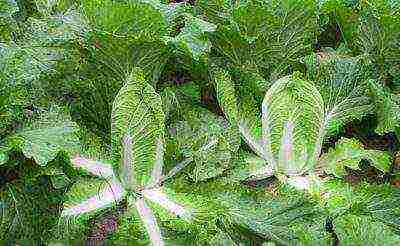 As already mentioned, not all varieties are suitable for growing in Russia. Some, such as the late-ripening Bokal variety, are capricious, so it is advisable to grow them in warm climates.
As already mentioned, not all varieties are suitable for growing in Russia. Some, such as the late-ripening Bokal variety, are capricious, so it is advisable to grow them in warm climates.
The variety Russian size was developed specifically for regions with a harsh climate., and the breeders were domestic biologists, therefore this variety is resistant to cold, unpretentious to the soil and early ripening.
Late-ripening varieties are recommended to be grown only in favorable climates. When planning to start growing Chinese cabbage, special attention should be paid to choosing a site for planting, preparing the soil and buying seed. It is important to take into account the climatic features of a particular region, because in many respects the timing will depend on them.
What colors are there?
There is green (classic) and red (purple) cabbage... Peking cabbage is purple in color. It is more resistant to cold weather than green cabbage and has a more pronounced taste. Moreover, purple Chinese cabbage is stored without losing quality for 4-5 months after picking.
Classification
The number of days before ripening indicated in the article is average, inaccurate. The ripening period is influenced by various factors, especially weather conditions.
Also, when we write “varieties suitable for cultivation in Russia”, we do not mean that the variety can be grown in any part of Russia, because the climate can be strikingly different in different parts of our country.
Before planting a particular strain, you need to know more about it and decide if it is suitable for growing in your area.
Early ripe
Early maturing varieties ripen earlier than all others, from two months after planting... At the same time, how quickly the cabbage ripens depends solely on each individual variety. For example, in the Vesnyanka variety from planting seeds to the moment of harvest, it usually takes about 35 days, for the Orange Mandarin variety - 40 days (if weather conditions are favorable), but for Cha-Cha - 50-55 days, although this variety is also considered early maturing.
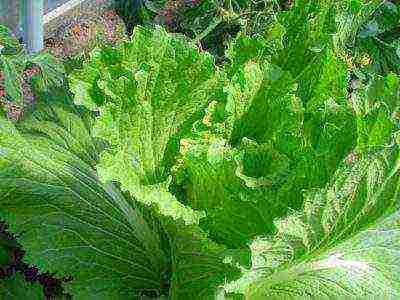 The best early maturing varieties include:
The best early maturing varieties include:
- Richie F1.
- Vesnyanka.
- Peking broadleaf.
- Semi-cabbage.
- TLCA 2.
- Lenok F1.
- Russian size.
- Cha-Cha.
- Orange tangerine.
- Yuki F1 (grown under a film, which promotes early maturation).
As a rule, those varieties of Peking cabbage that ripen early are not stored for long. An early ripe variety of Chinese cabbage with a period from the appearance of the first shoots to harvest in 45-50 days.
Mid-season
Varieties that ripen later than early maturing, but earlier than late maturing. A representative of mid-season Peking cabbage, variety Hydra F1, ripens in about 2 months, variety Bilko - also about that, 60-65 days.
Mid-season varieties suitable for growing in Russia include varieties:
- Garnet.
- Hydra F1.
- Slides f1.
- Lyubasha.
- Bilko.
- Brocken F1.
- Beijing Express (considered a mid-early variety).
Late ripening
Peking cabbage varieties that ripen the latest, that is, for the longest time. For instance, Peking cabbage variety Glass ripens in 70 days... These (late-ripening) varieties suitable for growing in Russia include varieties:
- Wineglass.
- Nika.
- Monument.
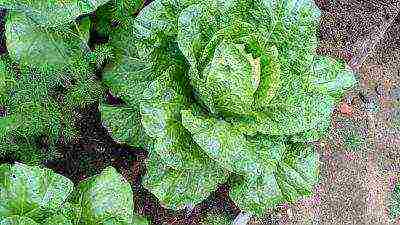 Late-ripening varieties of Peking cabbage are recommended to be grown exclusively in those regions of our country where a warm, mild, favorable climate prevails.
Late-ripening varieties of Peking cabbage are recommended to be grown exclusively in those regions of our country where a warm, mild, favorable climate prevails.
It is worth noting that if Vesnyanka and Bokal are very different from each other in terms of ripening time (30 and 70 days), then, say, the early ripening Cha-Cha variety, ripening in 50-55 days, and the mid-ripening Hydra F1 variety, ripening in a month, ripen close enough in time. Thus, it is not always worth chasing early ripening... If, say, some mid-season varieties have more advantages from your point of view.
Shooting and color resistant
Some varieties can develop flower stems, that is, arrows on which flowers subsequently form. Peking cabbage blooms instead of harvesting. Therefore, an important task was to develop varieties that are resistant to shooting and flowering. They now exist in abundance on the market. We advise you to choose just such varieties.
Peking cabbage varieties resistant to shooting and flowering:
- Champion.
- Manoko.
- Miraco.
- Optical.
- Bilko.
- Custar.
- Gilton.
Cabbage easily tolerates cold, but if it was exposed to low temperatures, then there is a high probability of its shooting. In general, Peking cabbage shooting occurs under any deterioration in weather conditions.
It is important to remember that resistance to shooting and flowering is not the only quality that a cultivated variety is desirable to possess! For example, the Champion variety is late ripening, so it is not suitable for growing in the cold regions of Russia.
Characteristics of the most popular types
Manoko F1
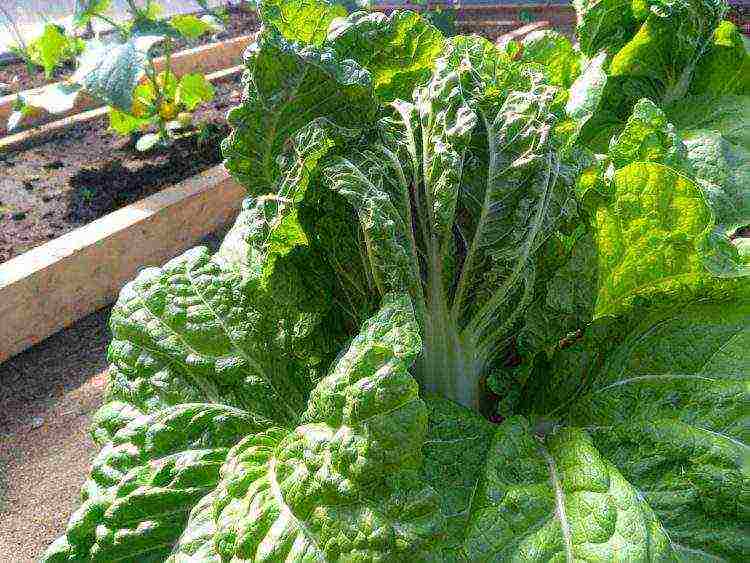
Variety resistant to flowering and intended for cultivation throughout the season both in the open field and in greenhouses. Ripening period Manoko - from 45 to 48 days, is considered an early maturing variety... Gives fruits of a cylindrical shape, light green color, weighing 0.8-1 kg.
It is considered a highly productive variety. Heat-resistant (due to its powerful root system), resistant to leaf browning and fusarium disease. It tolerates adverse climatic conditions well.
Wineglass
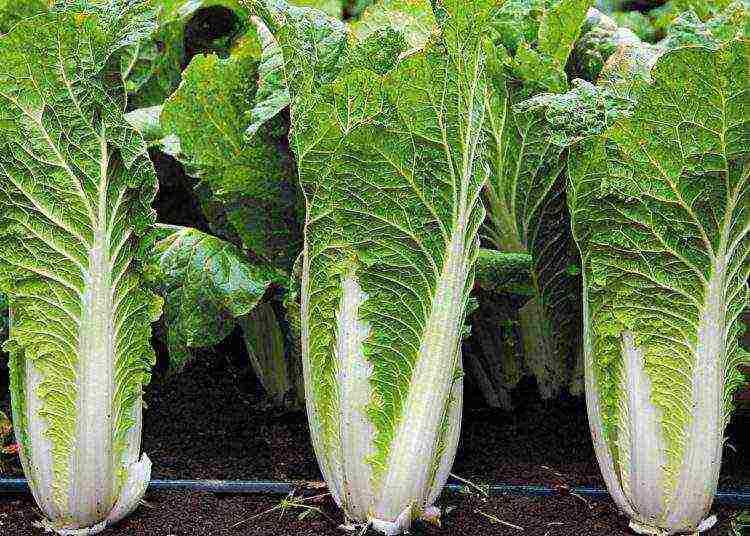
Peking cabbage variety that ripens in 70 days, so it can be attributed to both a late variety and a medium late variety. Heads of cabbage Glasses grow up to 2 kg in weight, have an oval shape, high density, there are no voids.
The heads of cabbage are so well closed that it would be difficult to penetrate the spores of fungi or larvae. In this regard, the heads of cabbage of the Goblet variety can be stored for quite a long time, and at the same time not spoil. The color of the heads of the Goblet variety is pleasantly light green.
The Bokal variety is quite capricious, so it is not recommended to grow it in the cold regions of Russia. Stalk resistance is often indicated in the description of this variety.
If you plant a Glass in the spring, it may well go into bloom.... In this regard, it is recommended to plant it only in the second half of the summer.
This variety can survive darkening without noticeable yield loss, which is quite unusual for the generally light-loving Peking cabbage. The taste qualities of this variety are high, therefore it is recommended to use it only in pure form or in salads - varieties with lower taste qualities can also be baked and cooked in soups.
Tenderness F1
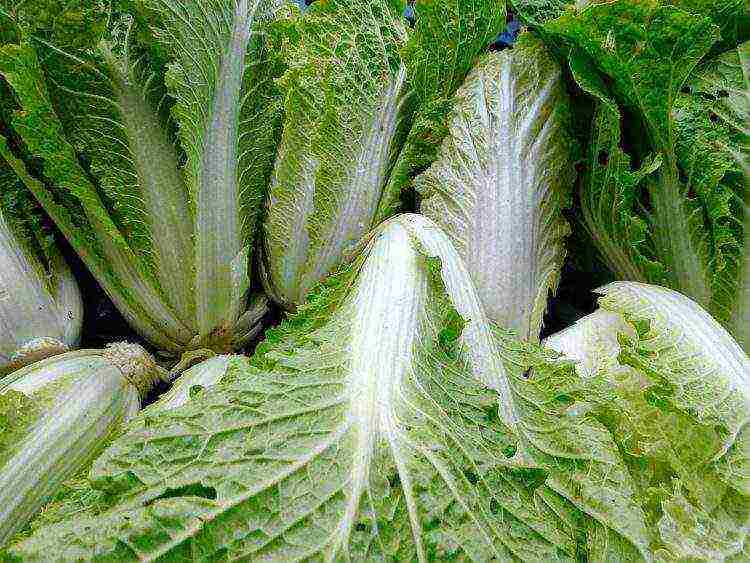
An early ripe variety bred by domestic producers. Ripening time - 45-48 days. Heads of cabbage are compact and small, the shape of a wide ellipse, medium density, weighing about 0.5 kg. Like most early maturing varieties, it is only suitable for short-term storage.
The leaves are juicy, bubbly, of a delicate consistency. Tastes good.The head of cabbage is yellowish-white in color. Hybrid Tenderness is resistant to keel and mucous bacteriosis... The first sowing for seedlings is carried out from 1 to 10 April. Pick - in the phase of cotyledons. Landing in the ground - in early May. The second sowing for seedlings is carried out on June 20. Disembarkation on July 5. The planting scheme is 40 by 60 cm.
The planting time cannot be delayed, as this variety of Peking cabbage is not resistant to flowering and can bloom.
They say that this variety is well suited for delicate salads, which fully justifies its name.
Nika
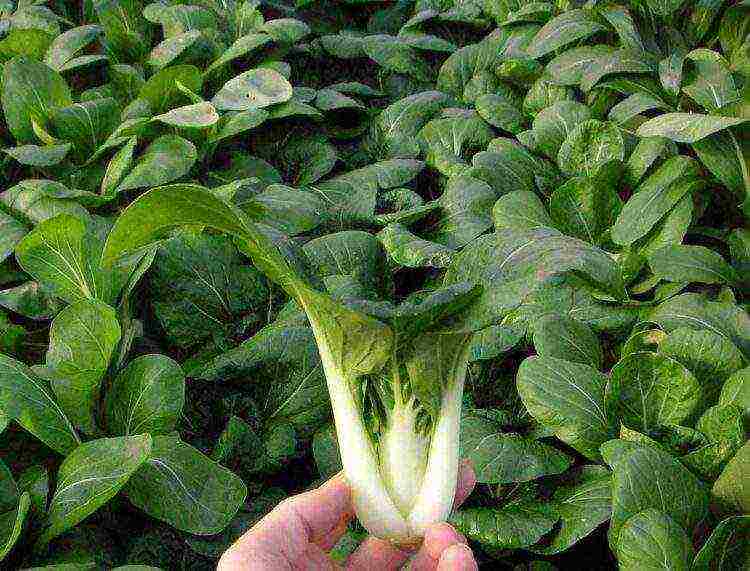
This mid-season variety has a high yield and keel resistance, ripens within about two months. Heads of cabbage are stored for a long time. This variety is picky about soil fertility. Cold resistant. The head of cabbage has the shape of a wide ellipse, dense, yellow in the cut, weighs 2-3 kg. Internal stump of medium length. The Nika variety has good taste..
Lyubasha

Mid-season variety, high-yielding, leaves are firm and crispy. The average ripening period is 2 months. It is believed that this variety of cabbage is good for Kim-Chi, and in principle for salads and side dishes. Not resistant to flowering. It tastes good and has a really wonderful and fresh aroma.
Martin
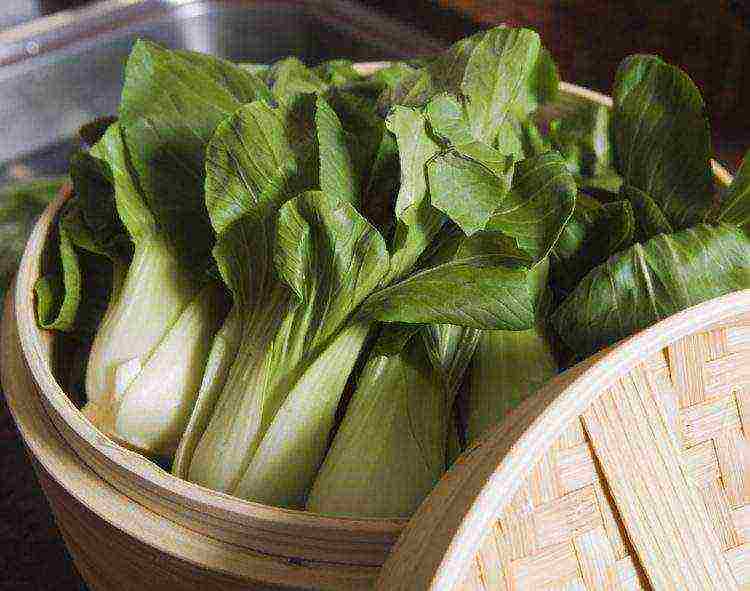
The Chinese swallow is an early maturing variety. From full germination to the beginning of technical maturity, it takes about 35-40 days. It is grown by sowing seeds in the ground. The rosette of leaves is half-raised, the leaf is whole, smooth, green, no pubescence. The petiole is fleshy, juicy, green, making up about 2/3 of the whole plant. The mass of one plant is from 1.5 to 3 kg.
Cha cha
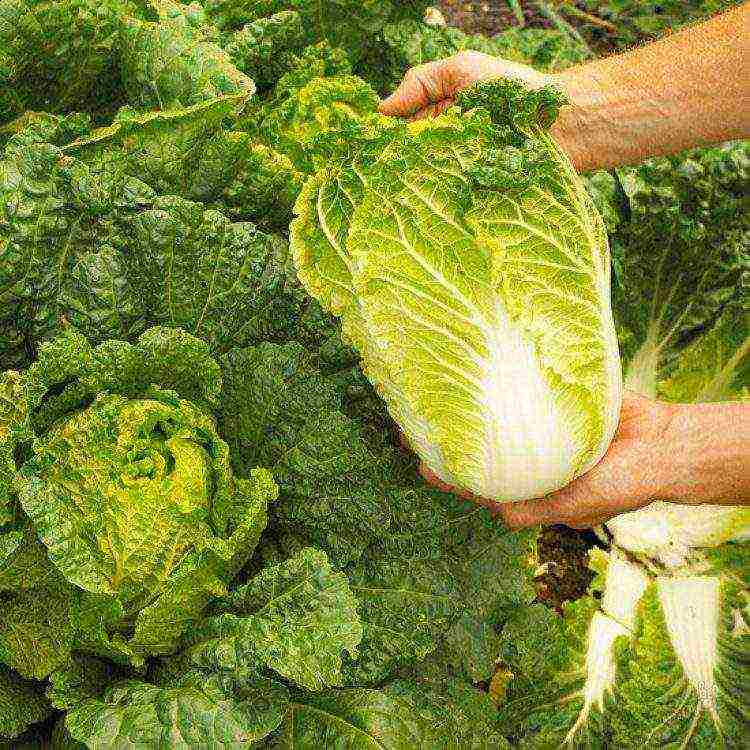
The Cha-cha variety takes about 50-55 days from the moment of planting the seeds to technical ripening.... The maximum weight of a head of cabbage is 2.8 kg, this variety of Peking cabbage is cultivated in a seedless way, which can make life much easier for those who decide to grow Peking cabbage on their own.
Cha-cha can be cultivated even in the Urals, but it will have a particularly high yield in the middle lane.
Bilko

Mid-season variety, ripening in 60-65 days. The mass of Bilko's heads is up to 1.5 kg. The leaves have a pleasant slightly sweet taste, crunchy. Unfortunately, Bilko cannot be stored for a very long time - no more than two months..
In accordance with the information provided, Manoko F1 can be called the best variety: it is early maturing, resistant to flowering, fusarium, heat and unfavorable climatic conditions.
Useful video
We offer you to watch a video about popular varieties of Peking cabbage:
Conclusion
So, we told you about the types of varieties of Peking cabbage and the varieties themselves, wrote what characteristics a good variety should have, and briefly described the qualities of each of the varieties. Our recommendations will help you choose which variety to plant in your garden.
Nevertheless, it is impossible to single out the best variety suitable for cultivation in all regions of Russia. You can only take a closer look at the individual varieties described in this article, and already learn more about them, looking for those that will be the most persistent, meet your requirements and the realities of the region in which you live. In doing so, you can surely find the variety of Peking cabbage to your liking.


